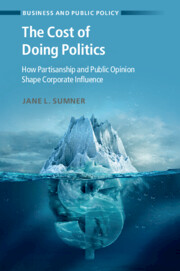Book contents
- Frontmatter
- Dedication
- Contents
- List of Figures
- List of Tables
- Acknowledgements
- 1 Introduction
- 2 Where Does Political Influence Come From?
- 3 How Does Public Opinion Shape Corporate Political Advocacy?
- 4 Why Does the Public Care About Corporate Political Influence?
- 5 Why Do Companies Care About Public Opinion?
- 6 Do Companies Try to Avoid Public Backlash?
- 7 So What and Now What? Summaries and Concluding Thoughts
- Appendix A: Interview Methods
- Appendix B: Chapter 4 Study Methodology and Full Results
- Appendix C: Chapter 5 Robustness Checks
- Appendix D: Chapter 6 Robustness Checks
- References
- Index
- Series page
4 - Why Does the Public Care About Corporate Political Influence?
Published online by Cambridge University Press: 21 April 2022
- Frontmatter
- Dedication
- Contents
- List of Figures
- List of Tables
- Acknowledgements
- 1 Introduction
- 2 Where Does Political Influence Come From?
- 3 How Does Public Opinion Shape Corporate Political Advocacy?
- 4 Why Does the Public Care About Corporate Political Influence?
- 5 Why Do Companies Care About Public Opinion?
- 6 Do Companies Try to Avoid Public Backlash?
- 7 So What and Now What? Summaries and Concluding Thoughts
- Appendix A: Interview Methods
- Appendix B: Chapter 4 Study Methodology and Full Results
- Appendix C: Chapter 5 Robustness Checks
- Appendix D: Chapter 6 Robustness Checks
- References
- Index
- Series page
Summary
In this chapter I ask why people respond negatively to corporate political advocacy. I argue that when people talk about boycotting a company, they are not really talking about their consumer behavior. Rather, calls for and supporting boycotts, especially in online formats, function in large part as a way for people to signal their partisanship to their social networks. In this way, disapproval of corporate advocacy in public serves dual functions of reaffirming someone’s individual partisan identity and also signaling loyalty to an in-group by disapproving of an out-group. I use two sources of evidence in this chapter: a survey with two embedded experiments and social media data on boycotts. The survey and experimental data use the individual as the unit of analysis to test whether disapproval of a company’s political activities is primarily partisan. The Twitter data focuses on what aspects of a tweet make it more likely to gain traction and be retweeted. In both tests, I find strong evidence that partisanship is a strong predictor of disapproving of a company’s political advocacy, as well as taking a public stance against it.
- Type
- Chapter
- Information
- The Cost of Doing PoliticsHow Partisanship and Public Opinion Shape Corporate Influence, pp. 84 - 129Publisher: Cambridge University PressPrint publication year: 2022

